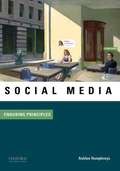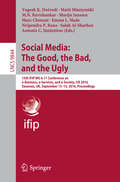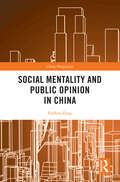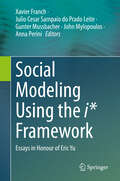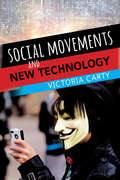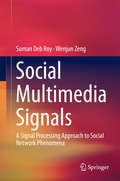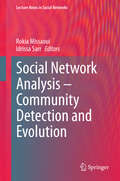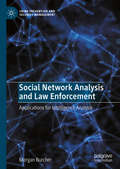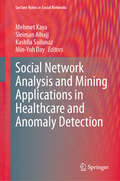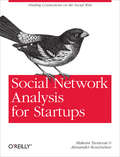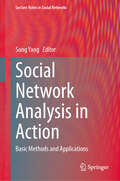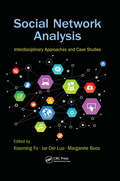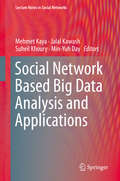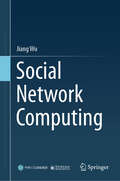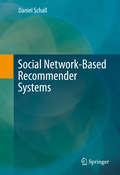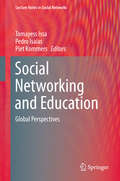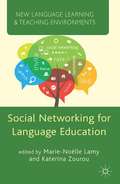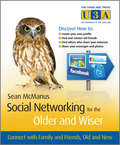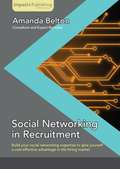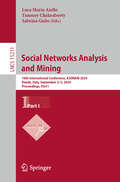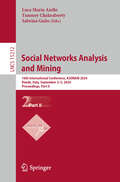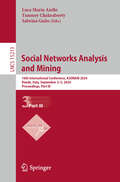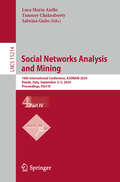- Table View
- List View
Social Media: Enduring Principles
by Ashlee HumphreysIntegrating the role of media in society with foundational research and theory, Social Media aims to open a well-structured, well-grounded conversation about media transition and its effects. Offering a comprehensive overview of topics, it covers not only cultural issues like online identityand community, but also tackles more analytical topics like social media measurement, network analysis, and social media economics at an introductory level.
Social Media: Marketing Strategies For Rapid Growth Using: Facebook, Twitter, Instagram, Linkedin, Pinterest And Youtube
by John WilliamsHow can 'Social Media: Marketing Strategies for Rapid Growth Using: Facebook, Twitter, Instagram, LinkedIn, Pinterest and YouTube' help you achieve this? <P><P> <P>Learn how to grow an engaged and supportive following on Facebook, Twitter, Instagram, Pinterest, YouTube and LinkedIn. <P>Tell your story and get your brands message across in a way that consumers enjoy and even look forward too. <P>Develop the skills needed to turn media consumers into paying customers <P>Learn the key demographics of each social media platform and how to use this to your advantage <P>Learn how to target your marketing to very specific groups of people for increased engagement and conversion <P>Learn how to improve your bottom line with more efficient marketing and cheaper customer acquisition <P>Take your business or brand to the Stratosphere! <P>Ideal for businesses of all sizes, brands and even personal pages <P>It's time to take your social media channels to new heights. It's time to grow your business the right way. Get relevant and dominate your platforms in 2016!
Social Media: The Good, the Bad, and the Ugly
by Yogesh K. Dwivedi Antonis C. Simintiras Nripendra P. Rana Marijn Janssen Matti Mäntymäki M. N. Ravishankar Marc Clement Emma L. Slade Salah Al-SharhanThis book constitutes the refereed conference proceedings of the 15th IFIP WG 6. 11 Conference on e-Business, e-Services and e-Society, I3E 2016, held in Swansea, UK, in September 2016 The 47 full and 17 short papers presented were carefully reviewed and selected from 90 submissions. They are organized in the following topical sections: social media strategy and digital business; digital marketing and customer relationship management; adoption and diffusion; information sharing on social media; impression, trust, and risk management; data acquisition, management and analytics; e-government and civic engagement; e-society and online communities.
Social Mentality and Public Opinion in China (China Perspectives)
by Fanbin ZengThis book explores the relationship between social mentality, public opinion, media, and other factors through mixed methods in China, especially since the 21st century.The book deploys qualitative and quantitative research and adopts a multi-disciplinary perspective and diversified research methods. The studies are built on and contribute to the burgeoning literature seeking to anatomize the relationship between social mentality, media, and public opinion from the point of view of sociology and communication. It also aims to explore how media can be used to appease public opinion. As the first systematic study of the interconnection between social mentality and public opinion, this book provides empirical support and a theoretical framework for both areas. It will thus be a great read for students and scholars of communication, sociology, and social psychology, especially for those with a focus on China and new media.
Social Modeling Using the i* Framework: Essays in Honour of Eric Yu
by John Mylopoulos Anna Perini Xavier Franch Gunter Mussbacher Julio Cesar Sampaio do Prado LeiteThis book is based on a symposium to celebrate Eric Yu, the inventor of the i* framework, held on the occasion of his retirement and collocated with the 31st IEEE International Requirements Engineering Conference. The notion of social modeling emerged in the mid-nineties as a powerful conceptual approach to intricately analyze and specify complex social ecosystems, wherein strategic actors collaborate and depend on each other in order to attain their goals. The i* framework was designed precisely for this purpose, rapidly establishing itself as the de facto standard in the requirements engineering and information systems communities. The invited chapters, which were all written by highly acclaimed researchers, aim to give testimony to the impact of Eric’s work during the last 30 years of research and practice in requirements engineering (RE) and at the same time reflect on current development as well as future prospects. The content of the book is structured into five sections, relative to the relationship of each chapter to the i* requirements modelling language. The first four sections cover retrospectives and reflections on i*, empirical research studies on i*, i* modelling language variants, and applications of i* to address open research challenges. The last section presents a chapter – written by Eric Yu himself – on a vision how i* could foster the transition towards a new RE paradigm, i.e., RE as Augmenting Aspiring Selves, a paradigm that should better fit with the needs of RE for AI-based systems. This compiled collection of retrospective, ongoing and forward-looking scholarly essays centered on the i* framework furnishes its readers with a holistic vision of social modeling through i*, encompassing its versatile applications across different domains, challenges, and scenarios.
Social Movements and New Technology
by Victoria CartyThe emergence of new information communication technologies--such as the Internet and social media networking sites and platforms--has strongly affected social movement activism. In this compelling and timely book, Victoria Carty examines these movements and their uses of digital technologies within the context of social movement theory and history. With an accessible and unique mix of theory and real-world examples, Social Movements and New Technology takes readers on a tour through MoveOn and Tea Party e-mail campaigns, the hacktavist tactics of Anonymous, global online protests against rapists and rape culture, and the tweets and Facebook pages that accompanied uprisings across the Arab world, Europe, and the United States. In each case study, the reader is invited to examine the movement, organization or protest and their use of digital tools through the lens of social movement theory. Discussion questions at the end of each chapter invite critical thinking and further reflection and debate.
Social Movements and New Technology
by Victoria CartyThe emergence of new information communication technologies-such as the Internet and social media networking sites and platforms-has strongly affected social movement activism. In this compelling and timely book, Victoria Carty examines these movements and their uses of digital technologies within the context of social movement theory and history. With an accessible and unique mix of theory and real-world examples, Social Movements and New Technology takes readers on a tour through MoveOn and Tea Party e-mail campaigns, the hacktavist tactics of Anonymous, global online protests against rapists and rape culture, and the tweets and Facebook pages that accompanied uprisings across the Arab world, Europe, and the United States. In each case study, the reader is invited to examine the movement, organization or protest and their use of digital tools through the lens of social movement theory. Discussion questions at the end of each chapter invite critical thinking and further reflection and debate.
Social Multimedia Signals
by Suman Deb Roy Wenjun ZengThis book provides a comprehensive coverage of the state-of-the-art in understanding media popularity and trends in online social networks through social multimedia signals. With insights from the study of popularity and sharing patterns of online media, trend spread in social media, social network analysis for multimedia and visualizing diffusion of media in online social networks. In particular, the book will address the following important issues: Understanding social network phenomena from a signal processing point of view; The existence and popularity of multimedia as shared and social media, how content or origin of sharing activity can affect its spread and popularity; The network-signal duality principle, i. e. , how the signal tells us key properties of information diffusion in networks; The social signal penetration hypothesis, i. e. , how the popularity of media in one domain can affect the popularity of media in another. The book will help researchers, developers and business (advertising/marketing) individuals to comprehend the potential in exploring social multimedia signals collected from social network data quantitatively from a signal processing perspective.
Social Network Analysis - Community Detection and Evolution
by Rokia Missaoui Idrissa SarrThis book is devoted to recent progress in social network analysis with a high focus on community detection and evolution. The eleven chapters cover the identification of cohesive groups, core components and key players either in static or dynamic networks of different kinds and levels of heterogeneity. Other important topics in social network analysis such as influential detection and maximization, information propagation, user behavior analysis, as well as network modeling and visualization are also presented. Many studies are validated through real social networks such as Twitter. This edited work will appeal to researchers, practitioners and students interested in the latest developments of social network analysis.
Social Network Analysis and Law Enforcement: Applications for Intelligence Analysis (Crime Prevention and Security Management)
by Morgan BurcherThis book examines the use of social network analysis (SNA) in operational environments from the perspective of those who actually apply it. A rapidly growing body of literature suggests that SNA can reveal significant insights into the overall structure of criminal networks as well as the position of critical actors within such groups. This book draws on the existing SNA and intelligence literature, as well as qualitative interviews with crime intelligence analysts from two Australian state law enforcement agencies to understand its use by law enforcement agencies and the extent to which it can be used in practice. It includes a discussion of the challenges that analysts face when attempting to apply various network analysis techniques to criminal networks. Overall, it advances SNA as an investigative tool, and provides a significant contribution to the field that will be of interest to both researchers and practitioners interested in social network analysis, intelligence analysis and law enforcement.
Social Network Analysis and Mining Applications in Healthcare and Anomaly Detection (Lecture Notes in Social Networks)
by Mehmet Kaya Min-Yuh Day Sleiman Alhajj Kashfia SailunazThis book is an excellent source of knowledge for readers interested in the latest developments in social network analysis and mining, particularly with applications in healthcare and anomaly detection. It covers topics such as sensitivity to noise in features, enhancing fraud detection in financial systems, measuring the echo-chamber phenomenon, detecting comorbidity, and evaluating the effectiveness of mitigative and preventative actions on viral spread in small communities using agent-based stochastic simulations. Additionally, it discusses predicting behavior, measuring and identifying influence, analyzing the impact of COVID-19 on various social aspects, and using UNet for handling various skin conditions. This book helps readers develop their own perspectives on adapting social network concepts to various applications. It also demonstrates how to use various machine learning techniques for tackling challenges in social network analysis and mining.
Social Network Analysis for Startups: Finding connections on the social web
by Alexander Kouznetsov Maksim TsvetovatDoes your startup rely on social network analysis? This concise guide provides a statistical framework to help you identify social processes hidden among the tons of data now available.Social network analysis (SNA) is a discipline that predates Facebook and Twitter by 30 years. Through expert SNA researchers, you'll learn concepts and techniques for recognizing patterns in social media, political groups, companies, cultural trends, and interpersonal networks. You'll also learn how to use Python and other open source tools—such as NetworkX, NumPy, and Matplotlib—to gather, analyze, and visualize social data. This book is the perfect marriage between social network theory and practice, and a valuable source of insight and ideas.Discover how internal social networks affect a company’s ability to performFollow terrorists and revolutionaries through the 1998 Khobar Towers bombing, the 9/11 attacks, and the Egyptian uprisingLearn how a single special-interest group can control the outcome of a national electionExamine relationships between companies through investment networks and shared boards of directorsDelve into the anatomy of cultural fads and trends—offline phenomena often mediated by Twitter and Facebook
Social Network Analysis in Action: Basic Methods and Applications (Lecture Notes in Social Networks)
by Song YangThis book offers a balanced view between a basic introduction of Social Network Analysis (SNA) in its methods and application, and advanced topics of data mining techniques and the subsequent SNA analyses. The book stands out as uniquely important contribution to the SNA field because it moves beyond the stage of basic SNA methods. It describes data mining techniques, introducing an online discourse collection platform, ICAS, which is developed by an interdisciplinary team involving Sociologists and Computer Engineer teams with supports of NSF funds.Targeted audiences of this book are students and scholars interested in using SNA techniques to advance their analytics of their respective research areas. This book provides particular utilities to students at the beginner stage of learning SNA basics, and those in their intermediary careers looking to advance their knowledges of what SNA has to offer. The unique features of this book lie in its descriptions of data mining techniques, data processing, and data analytics. The discussions of an online discourse network platform and data processing capabilities present tremendous benefits to those who aspire to mine the massive data of online social networking.
Social Network Analysis: Interdisciplinary Approaches and Case Studies
by Xiaoming Fu; Jar-Der Luo; Margarete BoosThe book addresses the issue of interdisciplinary understanding of collaboration on the topic of social network studies. Researchers and practitioners from various disciplines including sociology, computer science, socio-psychology, public health, complex systems, and management science have worked largely independently, each with quite different principles, terminologies, theories. and methodologies. The book aims to fill the gap among these disciplines with a number of the latest interdisciplinary collaboration studies.
Social Network Based Big Data Analysis and Applications (Lecture Notes In Social Networks Ser.)
by Suheil Khoury Jalal Kawash Mehmet Kaya Min-Yuh DayThis book is a timely collection of chapters that present the state of the art within the analysis and application of big data. Working within the broader context of big data, this text focuses on the hot topics of social network modelling and analysis such as online dating recommendations, hiring practices, and subscription-type prediction in mobile phone services. Manuscripts are expanded versions of the best papers presented at the IEEE/ACM International Conference on Advances in Social Networks Analysis and Mining (ASONAM’2016), which was held in August 2016. The papers were among the best featured at the meeting and were then improved and extended substantially. Social Network Based Big Data Analysis and Applications will appeal to students and researchers in the field.
Social Network Computing
by Jiang WuIn the era of digital economy with highly-connected world, the ability to comprehend social network computing has become an indispensable skill. This book serves as a vital guide for academics and professionals engaged in research within this rapidly expanding field. The book is organized into three parts, each dedicated to different facets of social network computing. The journey commences with an exploration of foundational principles, encompassing triadic closure, strong and weak ties, network homophily, and positive and negative balance. This lays the groundwork for an in-depth examination of fundamental theories governing social networks. Subsequently, the focus shifts to the laws dictating social networks, elucidating phenomena like the small world effect, power law distribution, community detection, diffusion processes, game theory dynamics, and hypernetworks, also including multiplex networks, multi-mode networks and temporal networks. The final section of the book centers on the practical aspects of social network analysis, delving into topics such as link prediction, influence evaluation, dynamic analysis, random experiments, modeling and simulation, and representation learning. This provides a comprehensive exploration of the applicability of social network analysis in real-world scenarios. This book seamlessly integrates theory with practice by incorporating popular social network computing software, including igraph, Gephi, Ucinet, and Netlogo. By mastering the computational thinking methods presented in this book, readers will deepen their understanding of social network computing and acquire the skills to effectively apply it in various real-world contexts.
Social Network-Based Recommender Systems
by Daniel SchallThis book introduces novel techniques and algorithms necessary to support the formation of social networks. Concepts such as link prediction, graph patterns, recommendation systems based on user reputation, strategic partner selection, collaborative systems and network formation based on 'social brokers' are presented. Chapters cover a wide range of models and algorithms, including graph models and a personalized PageRank model. Extensive experiments and scenarios using real world datasets from GitHub, Facebook, Twitter, Google Plus and the European Union ICT research collaborations serve to enhance reader understanding of the material with clear applications. Each chapter concludes with an analysis and detailed summary. Social Network-Based Recommender Systems is designed as a reference for professionals and researchers working in social network analysis and companies working on recommender systems. Advanced-level students studying computer science, statistics or mathematics will also find this books useful as a secondary text.
Social Networking and Education
by Pedro Isaias Tomayess Issa Piet KommersThe present work is intended to assist academics, researchers and proponents of online learning and teaching. Academics will be able to share the findings presented in this book, and the Social Networking and Education Model (SNEM), with their students (i. e. Masters and PhD). It is envisaged that this book will assist researchers and anyone interested in online learning to understand the opportunities and risks associated with the use of Social Networking in the education sector, and assist them to implement SN by means of the new SNEM model. The reader will benefit from our examinations of the risks and opportunities associated with the use of Social Networking in the education sector in various regions around the world: Asia-Pacific, Europe, Mediterranean, America, Middle East and the Caribbean. In addition, a Social Networking and Education Model (SNEM) will be developed to promote and implement Social Networking in the education sector.
Social Networking for Language Education
by Marie-Noëlle Lamy Katerina ZourouSocial networking is now one of the ways in which anyone can set out to learn or improve their language skills. This collection brings together different sets of learning experiences and shows that success depends on the wider environment of the learner, the kind of activity the learner engages in and the type of learning priorities he or she has.
Social Networking for the Older and Wiser: Connect with Family and Friends, Old and New (The\third Age Trust (u3a)/older And Wiser Ser.)
by Sean McManusSocial networks enable anyone with a computer and Internet connection to stay in touch with friends and family across the globe, and rediscover old acquaintances. Social Networking for the Older and Wiser starts with the basics of social networks, before moving onto intermediate topics, all whilst highlighting ways to protect your privacy and keep your details secure. The book is packed with step-by-step instructions on how to use Facebook, Twitter, Friends Reunited, Saga Zone, and other social networks to: Create an account on your chosen social network Reconnect and stay-in-touch with old friends Find others who share your interests and hobbies Share messages and photos Create your own social groups and clubs online So what are you waiting for? Join in on the social networking phenomenon that is sweeping the globe!
Social Networking in Recruitment
by Amanda BeltonBecome a professional social networking expert and give your organization a cost-effective advantage in the hiring market. Social networks have opened up whole new channels of communication between prospective employees and employers. They provide perfect opportunities to build a strong relationship with potential employees that ensures investment in recruitment is targeted towards a successful, cost effective hire. Social networks also allow an organization to build a strong employer brand that reaches the digital natives of the world, enabling the recruiter to achieve a competitive advantage. Author Bio: Amanda Belton is an IT manager specializing in agile and lean software development. In this instructional guide, Amanda will walk you through the practical steps to building a tailored approach to social networking, making the most of the resources already available within your organization.
Social Networks Analysis and Mining: 16th International Conference, ASONAM 2024, Rende, Italy, September 2–5, 2024, Proceedings, Part I (Lecture Notes in Computer Science #15211)
by Sabrina Gaito Luca Maria Aiello Tanmoy ChakrabortyThis LNCS conference 4-volume set constitutes the proceedings of the 16th International Conference on Social Networks Analysis and Mining, ASONAM 2024, in Rende, Italy, during September 2–5, 2024. The 33 full papers together with 36 short papers included in this volume were carefully reviewed and selected from 167 submissions. The conference covers a wide spectrum of research contributions to the foundations and applications of social networks.
Social Networks Analysis and Mining: 16th International Conference, ASONAM 2024, Rende, Italy, September 2–5, 2024, Proceedings, Part II (Lecture Notes in Computer Science #15212)
by Sabrina Gaito Luca Maria Aiello Tanmoy ChakrabortyThis LNCS conference 4-volume set constitutes the proceedings of the 16th International Conference on Social Networks Analysis and Mining, ASONAM 2024, in Rende, Italy, during September 2–5, 2024. The 33 full papers together with 36 short papers included in this volume were carefully reviewed and selected from 167 submissions. The conference covers a wide spectrum of research contributions to the foundations and applications of social networks.
Social Networks Analysis and Mining: 16th International Conference, ASONAM 2024, Rende, Italy, September 2–5, 2024, Proceedings, Part III (Lecture Notes in Computer Science #15213)
by Sabrina Gaito Luca Maria Aiello Tanmoy ChakrabortyThis LNCS conference 4-volume set constitutes the proceedings of the 16th International Conference on Social Networks Analysis and Mining, ASONAM 2024, in Rende, Italy, during September 2–5, 2024. The 33 full papers together with 36 short papers included in this volume were carefully reviewed and selected from 167 submissions. The conference covers a wide spectrum of research contributions to the foundations and applications of social networks.
Social Networks Analysis and Mining: 16th International Conference, ASONAM 2024, Rende, Italy, September 2–5, 2024, Proceedings, Part IV (Lecture Notes in Computer Science #15214)
by Sabrina Gaito Luca Maria Aiello Tanmoy ChakrabortyThis LNCS conference 4-volume set constitutes the proceedings of the 16th International Conference on Social Networks Analysis and Mining, ASONAM 2024, in Rende, Italy, during September 2–5, 2024. The 33 full papers together with 36 short papers included in this volume were carefully reviewed and selected from 167 submissions. The conference covers a wide spectrum of research contributions to the foundations and applications of social networks.
